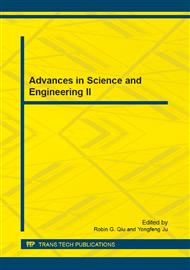[1]
M. Mambo, K. Usuda, E. Okamoto, Proxy signatures: delegation of the power to sign messages, IEICE Trans. Fundam. Electron. Commun. Comput. Sci. E79-A(9)(1996)1338-1354.
Google Scholar
[2]
B. Lee, H. Kim, K. Kim, Strong proxy signature and its application, Australasian Conference on Information Security and Privacy (ACISP'2001), LNCS 2119, pp.603-608.
Google Scholar
[3]
L. J. Yi, G. Q. Bai, G. Z. Xiao, Proxy multi-signature scheme: a new type of proxy signature scheme, Electron. Lett. 36(6)(2000)527-528.
DOI: 10.1049/el:20000422
Google Scholar
[4]
C.Y. Lin, T. C. Wu, J. J. Hwang, Multi-proxy Signature Schemes for Partial Delegation with Cheater Identification, The Second Int. Workshop for Asia Public Key Infrastructure. IOS Press, Amsterdam, Netherlands, 2002, pp.147-152.
Google Scholar
[5]
Q. Xue, Z. Cao, Improvement of Multi-Proxy Signature Scheme, Fourth Int. Conf. on Computer and Information Technology, 2004, pp.450-455.
Google Scholar
[6]
L. F. Guo, G. L. Wang, Insider attacks on multi-proxy multi-signature schemes, Computers and Electrical Engineering 33 (2007)88-93.
DOI: 10.1016/j.compeleceng.2006.08.003
Google Scholar
[7]
G. X. Jiang, A New Proxy Multi-signature Scheme, International Conference on Networking and Digital Society, 2(2009)20-23.
Google Scholar
[8]
G. L. Wang, F. Bao, J.Y. Zhou, R. H. Deng, Security Analysis of Some Proxy Signatures, Information Security and Cryptology - ICISC 2003, LNCS 2971, pp.305-319.
DOI: 10.1007/978-3-540-24691-6_23
Google Scholar
[9]
A. Boldyreva, A. Palacio, B. Warinschi, Secure proxy signature schemes for delegation of signing rights, http: /eprint. iacr. org/2003/096, (2003).
DOI: 10.1007/s00145-010-9082-x
Google Scholar
[10]
M. Girault, Self-certified public keys, LNCS 547, 1991, pp.490-497.
Google Scholar
[11]
A. J. Menezes, P. C. Oorschot, S.A. Vanstone, Handbook of Applied Cryptograph, CRC Press, New York, (1997).
Google Scholar
[12]
K. Nyberg, R. A. Rueppel, Message Recovery for Signature Schemes Based on the Discrete Logarithm, Designs, Codes and Cryptography , 7 (1996) 61-81.
DOI: 10.1007/bf00125076
Google Scholar
[13]
T. S. Wu, C. L. Hsu, H.Y. Lin, Self-certified multi-proxy signature schemes with message recovery, J. Zhejiang Univ. Sci. A 10(2)(2009)290-300.
DOI: 10.1631/jzus.a0820202
Google Scholar
[14]
Q. Xie, J. Wang, X. Yu, Improvement of nonrepudiable threshold multi-proxy threshold multi-signature scheme with shared verification, Journal of Electronics 24(6)(2007)806-811.
DOI: 10.1007/s11767-006-0047-z
Google Scholar


